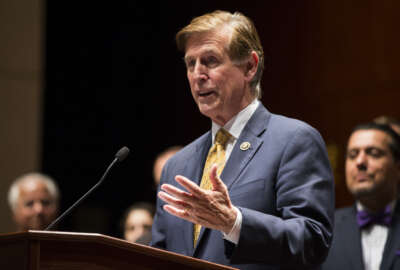
Omnibus endorses 1% federal pay raise, gives feds more time to repay deferred payroll taxes
A provision in the 2021 omnibus spending package gives federal employees a full 12 months to repay the payroll taxes that have been deferred from their paychecks...
Latest updates on the vote here.
Federal employees and military members will have an easier time paying back the Social Security taxes that have been deferred from their paychecks over the last three months, thanks to a provision tucked inside the massive omnibus spending package Congress unveiled Monday afternoon.
The provision will allow those subject to the president’s payroll tax deferral to pay back the deferred taxes — worth 6.2% of their income — throughout the entire year of 2021.
Information about the program and the expectations for federal employees and service members to pay back the deferred taxes has been relatively sparse. But the general plan, according to federal payroll providers, was for employees to begin paying the deferred taxes back between January and April 2021.
Now, federal employees and servicemembers will have 12 months instead of the original four to repay previously deferred taxes.
In a statement, Rep. Don Beyer (D-Va.) said the provision would help minimize the damage federal employees and servicemembers would otherwise experience next year.
Exact repayment details are still unclear, but federal employees and military members will likely have this year’s deferred taxes taken out in gradual installments through their 2021 paychecks.
The National Treasury Employees Union praised the provision.
“NTEU was concerned that requiring employees to pay the deferred taxes in just four months was too short and would present a financial burden to federal employees, especially because they were forced to participate in the deferral with little or no notice,” NTEU National President Tony Reardon said Monday in a statement. “The amount of deferred taxes will be withheld over 26 pay periods instead of eight, which is a fair resolution to a short-sighted policy that only affected civilian and military federal employees in the executive branch and no one else.”
The provision is part of a massive $1.4 trillion omnibus spending bill and $900 billion COVID-19 relief package. Congress reached an agreement on the broad pieces of a major COVID-19 relief package over the weekend and finalized the legislative text Monday morning.
Both the House and Senate are expected to start voting on the package Monday, though the timing is still unclear. Current funding levels expire Monday at 11:59 p.m.
The payroll tax deferral stemmed from an executive memo President Donald Trump signed back in August. The administration billed the program as a tax holiday and paycheck boost for American workers during the pandemic, but few private sector employers chose to implement it.
The deferral was mandatory for most federal employees and military members whose gross, biweekly wages were $4,000 or less. The U.S. Postal Service, Senate and House of Representatives chose to opt out of the program this fall.
Members of Congress had been pushing the administration to give federal employees the chance to opt in or out of the president’s payroll tax deferral. But it never happened, and most federal payroll providers have been deferring Social Security taxes from employees’ paychecks since mid-September.
The payroll tax deferral will continue through employees’ last paycheck of the year.
“Our federal employees and service members should never have been pawns in Trump’s payroll tax scheme,” Sen. Chris Van Hollen (D-Md.) said in a statement to Federal News Network. “But despite Republicans’ cowardice in refusing to stick up for these public servants by making the deferral optional, this provision to extend the payment period will provide at least some relief to those caught in Trump’s political shell game.”
Omnibus effectively endorses 1% federal pay raise
The omnibus spending package is also silent on a federal pay raise for civilian employees in 2021.
In their silence, Congress has effectively endorsed the president’s original proposal of a 1% across-the-board raise for civilian employees next year.
The president broke with tradition and submitted his formal federal pay plans to Congress back in February, a move that administrations usually reserve for the end of August. By statute, the president must announce his intentions for federal pay by Aug. 31 of each year.
Congress did not adopt a federal pay freeze for civilian employees next year, which Senate Republicans introduced and the White House informally endorsed this fall. The original proposal from the House remained silent on the topic of federal pay.
Even once Congress passes the omnibus spending package, the president must sign an executive order implementing the 1% federal pay raise before the year ends.
Some federal employees have expressed skepticism the president would reverse course and issue a pay freeze via an executive order at the end of the year.
To date, there’s no precedence for a president reversing course on an across-the-board raise and issuing an EO that fundamentally differed from the pay plan he submitted to Congress earlier in the year.
President Barack Obama changed his mind on federal pay near the end of 2016, issuing an executive order in late December that implemented a 2.1% pay raise for civilian employees, higher than the 1.6% bump he originally proposed to Congress earlier in the year.
But the order only adjusted locality pay for civilian employees, not the across-the-board raise that applies to all federal workers regardless of their location.
NTEU and the National Active and Retired Federal Employees (NARFE) Association expressed mild enthusiasm about the likely 1% pay bump for civilian workers but were disappointed it didn’t match the 3% raise active-duty servicemembers will receive in 2021.
No congressional attempt to block Schedule F
The omnibus spending package doesn’t, however, include language blocking the president’s Schedule F executive order, which House and Senate Democrats, as well as federal employee and good government groups, had been pushing congressional leadership to include.
The executive order, which Trump released in late October, gives agency heads the authority to reclassify certain federal employees in policy-making positions into a new schedule of quasi-political appointees known as Schedule F. Career federal employees would lose their civil service protections in the process, meaning their agency heads could fire them — and hire new replacements — at will.
Federal employee groups have been particularly concerned the executive order will disrupt the presidential transition and pandemic recovery efforts if agencies move career civil servants and political appointees into Schedule F before Inauguration Day. Implementing the Schedule F executive order now could have potentially lingering effects on agencies, even if the incoming Biden administration chooses to repeal the EO in the early days of his term, the groups have said.
House Majority Leader Steny Hoyer (D-Md.), who co-sponsored standalone legislation attempting to block the Schedule F executive order, put the blame on Republicans for not including the language.
“Reports that agencies are moving forward with this order in the waning weeks of the Trump administration are deeply alarming and would seriously harm the ability of our government to serve its citizens,” he said in a statement. “I’ll work with the incoming Biden-Harris administration to reverse this harmful order and undo President Trump’s attempts to undermine the federal civilian workforce.”
NARFE, which had been leading the charge to block the Schedule F executive order through the omnibus spending bills, said it was “deeply disappointed” Congress didn’t act.
Failing to block the Schedule F executive order gives the Trump administration a “green light” to continue implementing the EO, said Ken Thomas, NARFE’s national president.
“Unfortunately, Congress has abrogated its responsibility to ensure checks on either the current or future administration’s implementation of the executive order and use of the new authority,” he said Monday in a statement. “It is irresponsible to provide trillions in funding in the hopes that government will run smoothly, while declining to do anything to ensure the result. Full scale implementation of Schedule F and use of the authority to remove employees would not only undermine distribution of appropriated funds but also funds authorized through the COVID relief package.”
Copyright © 2025 Federal News Network. All rights reserved. This website is not intended for users located within the European Economic Area.
Nicole Ogrysko is a reporter for Federal News Network focusing on the federal workforce and federal pay and benefits.
Follow @nogryskoWFED







